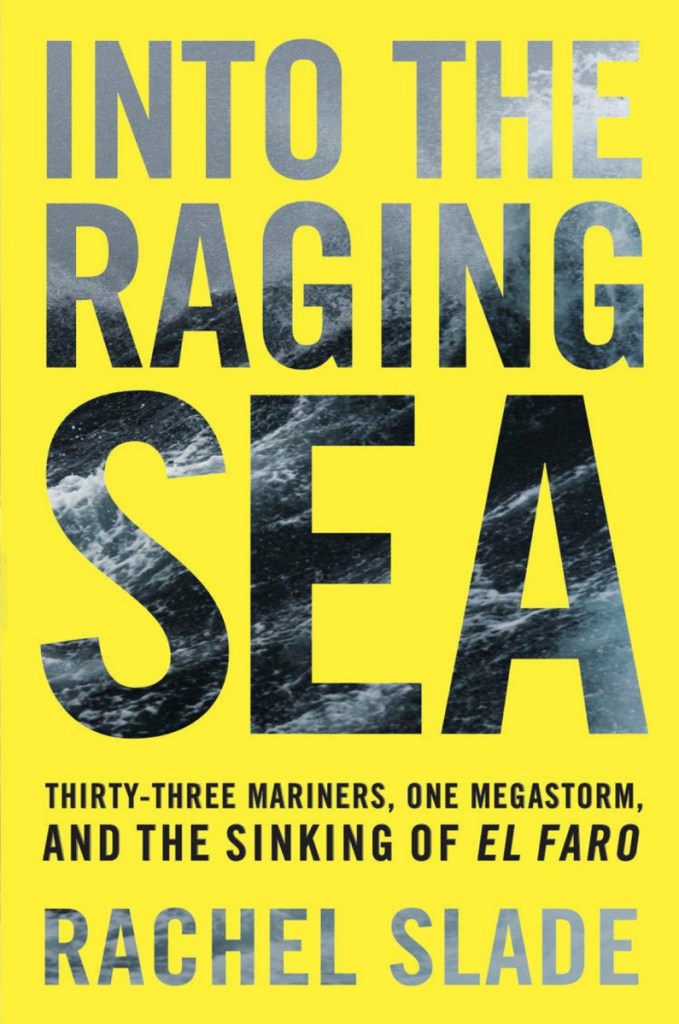In the aftermath of a tragedy, certain questions inevitably come to mind: What went wrong? How did this happen? And, even more heartbreaking, could this have been prevented? Rachel Slade’s “Into the Raging Sea” is both a gripping account of the final voyage of El Faro, a cargo ship that sank in Hurricane Joaquin in 2015, and a moving portrait of many of the lives lost in the disaster, including those of four Mainers.
If Slade’s book had done nothing other than tell the tale of this horrific event, it would have been gripping enough. But there’s another aspect to “Into the Raging Sea,” which places the disaster in an entirely different context and infuses a weighty subject with righteous anger.
The first part of “Into the Raging Sea” draws a detailed picture of life on board El Faro. Slade zeroes in on several members of the crew, investigating their personal histories and delving into why maritime life appealed to them. She creates a sense of the dynamics on board the ship, portraying who on the crew was close and where interpersonal conflicts arose. Through these very specific examples, Slade also provides a look at the appeal of a maritime life and its effect on the psyche of those who spend weeks or months at a time at sea. As she’s doing this, she’s also building a sense of mounting dread, showing how a blend of technological failures and errors in judgment led the ship to venture into the storm – the crew not realizing how bad the situation was until it was far too late.
“The rumbling and heaving of a ship in a storm can throw you right out of bed,” she writes to describe El Faro’s progression into the worsening storm. “Back and forth, from one side to the other, your body’s weight goes with the ship. You lose your sense of up; the world becomes a sickening swirl of constant, unpredictable motion.”
The book’s second half is set after El Faro sank, focusing first on the efforts to find survivors (there were none), and then on an analysis of the wreckage to determine what exactly happened. This narrative is a different kind of gripping: The process of flying a rescue mission into a hurricane is described with meticulous (and nerve-wracking) detail, while the story of the investigation of the wreckage, and the hearings that followed, blend technology with a sense of measured frustration in the face of terrible events.
Slade meticulously explores the cut corners and cost-saving measures that, had they not been implemented, could have meant a different outcome for El Faro – from corporate consolidation that resulted in the loss of institutional memory to decisions to allow an outdated form of life vessel to remain on board. What happened when El Faro sank, taking the lives of its crew of 33, was a profound tragedy, Slade convincingly argues, but it was also an eminently preventable one, with roots in government cutbacks and corporate mergers.
Slade has followed these events for some time; she first wrote about El Faro for Yankee magazine. That familiarity shows: She deftly conveys a number of complex interpersonal and inter-agency relationships, from the personal dynamics on board El Faro, to the different groups participating in recovery efforts after the ship sank, to the conflicting motivations of government and corporate entities working to assign responsibility for the tragedy.
She also distills an expanse of information into easily digestible parcels, including the complex evolution of cargo-ship design, and the impact globalization has had on ship design. Here, too, there’s a sense of interconnectedness; the way that older ships were modified to bring them in line with the shipping methodologies in use in a given period also pertains to how those ships can be managed under certain weather conditions – the high winds and raging waves of a hurricane, for example.
Throughout the book, Slade hints at the nautical tragedies that predated this one, at the similar events that have also entered the public consciousness. At one point, she refers to the film adaptation of Sebastian Junger’s “The Perfect Storm,” and she makes a few nods to the 2012 sinking of the replica of the Bounty in Hurricane Sandy. Reading skillfully told stories of tragedies on the open water can feel like a punch to the gut. Slade does that neatly here, while also paying tribute to the ship’s crew and exploring their legacies. It’s a staunchly humanistic work, adroitly told, with a wide emotional range that incorporates both a sense of loss and a call for change.
New York City resident Tobias Carroll is the author of the novel “Reel” and the short story collection “Transitory” and has reviewed books for Bookforum, the Star Tribune and elsewhere.
Copy the Story LinkSend questions/comments to the editors.



Success. Please wait for the page to reload. If the page does not reload within 5 seconds, please refresh the page.
Enter your email and password to access comments.
Hi, to comment on stories you must . This profile is in addition to your subscription and website login.
Already have a commenting profile? .
Invalid username/password.
Please check your email to confirm and complete your registration.
Only subscribers are eligible to post comments. Please subscribe or login first for digital access. Here’s why.
Use the form below to reset your password. When you've submitted your account email, we will send an email with a reset code.